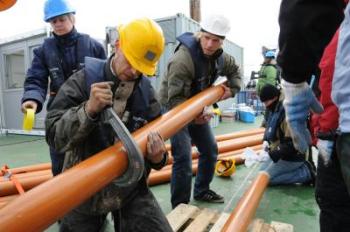Mar 28 2013
Single-celled archaea are invisible to the naked eye, and even when using a microscope, great care must be taken to observe them. An international team of researchers led by the Center for Geomicrobiology, Aarhus University, Denmark, has nevertheless succeeded in retrieving four archaeal cells from seabed mud and mapping the genome of each one.
 The core sample has just been brought up from the bottom of the Bay of Aarhus and is being cut up. The researchers find archaea in the samples, which -- to their great surprise -- turn out to live on protein degradation. Credit: Bo Barker Jorgensen
The core sample has just been brought up from the bottom of the Bay of Aarhus and is being cut up. The researchers find archaea in the samples, which -- to their great surprise -- turn out to live on protein degradation. Credit: Bo Barker Jorgensen
"Until now, nobody knew how these widespread mud-dwelling archaea actually live. Mapping the genome from the four archaeal cells shows they all have genes that enable them to live on protein degradation," says Professor Karen Lloyd, now at the University of Tennessee, and leading author of the ground-breaking results published in the renowned journal Nature.
Scientists previously thought that proteins were only broken down in the sea by bacteria, but archaea have now turned out to be important new key organisms in protein degradation in the seabed. Proteins actually make up a large part of the organic matter in the seabed and – since the seabed has the world's largest deposit of organic carbon – archaea thus appear to play an important and previously unknown role in the global carbon cycle.
Like a grain of sand on the beach
Archaea are some of the most abundant organisms in the world, but very few people have ever heard of them. They were originally discovered in extreme environments such as hot springs and other special environments like cow stomachs and rice paddies, where they form methane. In recent years, however, researchers have realised that archaea make up a large part of the microorganisms in the seabed, and that the seabed is also the habitat of the majority of the world's microorganisms.
"A realistic estimate is that archaea are the group of organisms with the most individuals in the world. In fact, there are more archaea than there are grains of sand on the beaches of the whole world. If you bury your toes right down in the mud in the seabed, you'll be in touch with billions of archaea," says Professor Bo Barker Jørgensen, Director of the Center for Geomicrobiology.
New technology links function and identity
This is the first time that scientists have succeeded in classifying archaeal cells in a mud sample from the seabed and subsequently analysing the genome of the cells, thereby revealing what the organisms are and what they live on.
"At present, we can't culture these archaea or store them in the laboratory, so this rules out the physiological tests usually carried out by the microbiologists. We've therefore worked with cell extraction, cell sorting, and subsequent mapping of the individual cell's combined genetic information – that's to say its genome. This is a new approach that can reveal both a cell's identity and its lifestyle," says Professor of Microbiology Andreas Schramm, affiliated with the Center for Geomicrobiology.
The method opens up a new world of knowledge for microbiologists, who can now study an individual microorganism just as zoologists study an individual mouse. Microbiologists have been hoping for this for a long time. Until now, they have only been familiar with the life processes of less than 1% of the world's microorganisms – those they can culture in a laboratory. The new method provides opportunities for studying the remaining 99% directly from nature.
"Applying this novel technique to marine sediments means we don't have to wait a thousand years for archaea to grow in lab to analyze their genomes – we can just sequence them directly from the environment. In future, this method will no doubt reveal new, unknown functions of microorganisms from many different environments, concludes Postdoctoral Fellow Dorthe Groth Petersen.